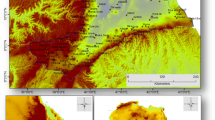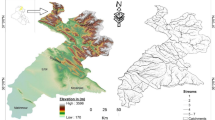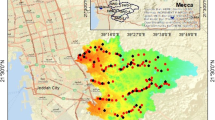Abstract
Jamaica, the third largest island in the Caribbean, has been affected significantly by flooding and flood-related damage. Hence assessing the probability of flooding and susceptibility of a place to flood hazard has become a vital part of planning and development. In addition to heavy rainfall from tropical storms and Atlantic hurricanes, several terrestrial factors play significant roles in flooding, including local geology, geomorphology, hydrology and land-use. In this study, a GIS-based multi-criteria statistical methodology was developed to quantify hazard potential and to map flood characteristics. Fourteen factors potentially responsible for flooding were identified and used as initial input in a hybrid model that combined principal component analysis with logistic regression and frequency distribution analysis. Of these factors, seven explained 65 % of the variation in the data: elevation, slope angle, slope aspect, flow accumulation, a topographic wetness index, proximity to a stream network, and hydro-stratigraphic units. These were used to prepare the island’s first map of flood hazard potential. Hazard potential was classified from very low to very high, nearly one-fifth (19.4 %) of the island was included within high or very high flood hazard zones. Further analysis revealed that areas prone to flooding are often low-lying and flat, or have shallow north- or northwest-facing slopes, are in close proximity to the stream network, and are situated on underlying impermeable lithology. The multi-criteria hybrid approach developed could classify 86.8 % of flood events correctly and produced a satisfactory validation result based on the receiver operating characteristic curve. The statistical method can be easily repeated and refined upon the availability of additional or higher quality data such as a high resolution digital elevation model. Additionally, the approach used in this study can be adopted to evaluate flood hazard in countries with similar characteristics, landscapes and climatic conditions, such as other Caribbean or Pacific Small Island Developing States.







Similar content being viewed by others
References
Abdul-Wahab S, Bakheit C, Al-Alawi S (2005) Principal component and multiple regression analysis in modelling of ground-level ozone and factors affecting its concentrations. Environ Model Softw 20(10):1263–1271
Altman D (1991) Categorizing continuous covariates (letter to the editor). Br J Cancer 64:975
Altman D, Lausen B, Sauerbrei W, Schumacher M (1994) Dangers of using ‘optimal’ cutpoints in the evaluation of prognostic factors. J Nat Cancer Inst 86:829–835
Bates PD, Wilson MD, Horritt MS, Mason D, Holden N, Currie C (2006) Reach scale floodplain inundation dynamics observed using airborne Synthetic Aperture Radar imagery: data analysis and modelling. J Hydrol 328:306–318
Bathrellos GD, Kalivas DP, Skilodimou HD (2009) GIS-based landslide susceptibility mapping models applied to natural and urban planning in Trikala Central Greece. Estud Geol Madr 65(1):49–65
Bathrellos GD, Gaki-Papanastassiou K, Skilodimou HD, Papanastassiou D, Chousianitis KG (2012) Potential suitability for urban planning and industry development by using natural hazard maps and geological—geomorphological parameters. Environ Earth Sci 66(2):537–548
Bathrellos GD, Gaki-Papanastassiou K, Skilodimou HD, Skianis GA, Chousianitis KG (2013) Assessment of rural community and agricultural development using geomorphological-geological factors and GIS in the Trikala prefecture (Central Greece). Stoch Environ Res Risk Assess 27(2):573–588
Beven K, Kirby M (1979) A physically based, variable contributing area model of basin hydrology. Hydrol Sci B 24:43–69
Burgess C, Taylor M, Stephenson T, Mandal A (2013) Extreme precipitation for Jamaica: 1895–2100. International Conference on Flood Resilience: experiences in Asia and Europe. Exeter, United Kingdom: University of Exeter
Burgess C, Taylor M, Stephenson T, Mandal A, Powell L (2015) A macro scale flood risk for Jamaica with impact of climate variability. Nat Haz 48(1):231–256
Carby B (2011) Mid-term review of the hyogo framework for action in the caribbean. In: Hutchinson G, Harris D (eds) University of the west indies, in PIOJ, 2012a. A Growth-Inducement Strategy for Jamaica. Planning Institute of Jamaica. Kingston, Jamaica
Chang H, Franczyk J, Kim C (2009) What is responsible for increasing flood risks? The case of Gangwon Province, Korea. Nat Haz 48(3):339–354
Chubey M, Hathout S (2004) Integration of RADARSAT and GIS modeling for estimating Red River flood risk. GeoJour 59:237–246
Chung C, Fabbri A (2003) Validation of spatial prediction models for landslide hazard mapping. Nat Haz 30:451–472
Collymore J (2007) Disaster management in the Caribbean: perspectives on institutional capacity reform and development. Environ Haz 10(1):6–22
Collymore J (2011) Disaster management in the Caribbean: perspectives on institutional capacity reform and development. Environ Haz 10(1):6–22
CRIES (Comprehensive Resources Inventory and Evaluation Systems) (1985) Jamaica Resource Assessment, Comprehensive Resource Inventory and Evaluation System Project, Michigan State University, U.S. Department of Agriculture/Soil Conservation Service, Ohio State University, U.S.A. p 230
Dai F, Lee C, Li J, Xu Z (2001) Assessment of landslide susceptibility on the natural terrain of Lantau Island, Hong Kong. Environ Geol 40:381–391
Dixon B (2005) Applicability of neuro-fuzzy techniques in predicting ground-water vulnerability: a GIS-based sensitivity analysis. J Hydrol 309:37–38
ECLAC (2001) Jamaica: assessment of the damage caused by flood rains and landslides in association with hurricane Michelle, October 2001. Implications for economic, social and environmental development. p 46
Fekete A (2009) Validation of a social vulnerability index in context to river-floods in Germany. Nat Haz Earth Syst Sci 9:393–403
Ghalkhani H, Golian S, Saghafian B, Farokhnia A, Shamseldin A (2013) Application of surrogate artificial intelligent models for real-time flood routing. Water Environ J 27:535–548
Grabs T, Seibert J, Bishop K, Laudon H (2009) Modeling spatial patterns of saturated areas: a comparison of the topographic wetness index and a dynamic distributed model. J Hydro 373:15–23
Guha-Sapir D, Below R, Hoyois PH (2010) EM-DAT: international disaster database. Université Catholique de Louvain, Brussels
Hilsenbeck S, Clark G (1996) Practical p-value adjustment for optimally selected cutpoints. Stat Med 15:103–112
Hosmer D, Lemeshow S (2000) Applied logistic regression. Wiley, New York, p 383
Hsu K, Gupta HV, Gao X, Sorooshian S, Imam B (2002) Self-organizing linear output map (SOLO): an artificial neural network suitable for hydrologic modeling and analysis. Water Res Res 38(1):17–38
Hu T, Lam K, Ng S (2001) River flow time series prediction with a range dependent neural network. Hydro Sci J 46(5):729–745
Hunter NM, Bates PD, Horritt MS, Wilson MD (2007) Simple spatially-distributed models for predicting flood inundation: a review. Geomorph 90(3–4):208–225
Imric C, Durucan S, Korre A (2000) River flow prediction using artificial neural networks: generalisation beyond the calibration range. Hydrol 233:138–153
Jourde H, Lafare A, Mazzilli N, Belaud G, Neppel L, Dörfliger N, Cernesson F (2014) Flash flood mitigation as a positive consequence of anthropogenic forcing on the groundwater resource in a karst catchment. Environ Earth Sci 71(2):573–583
Keating A, Campbell K, Mechler R, Michel‐Kerjan E, Mochizuki J, Kunreuther H, Bayer J, Hanger S, McCallum I, See L, Williges K, Atreya A, Botzen W, Collier B, Czajkowski J, Hochrainer S, Egan C (2014) Operationalizing resilience against natural disaster risk: opportunities, barriers and a way forward, Zurich Flood Resilience Alliance
Kendall M (1957) A course in multivariate analysis. Griffin, London, p 185
Kia MB, Pirasteh S, Pradhan B, Mahmud AR, Sulaiman WNA, Moradi A (2012) An artificial neural network model for flood simulation using GIS: Johor River Basin, Malaysia. Environ Earth Sci 67:251–264
Kim G, Barros A (2001) Quantitative flood forecasting using multisensor data and neural networks. J Hydrol 246(1–4):45–62
Kleinbaum DG, Klein M (2002) Modeling strategy for assessing interaction and confounding. In: Kleinbaum DG, Klein M (eds) Logistic regression: a self-learning text. Springer, New York
Knebl M, Yang Z, Hutchison K, Maidment D (2005) Regional scale flood modeling using NEXRAD rainfall, GIS and HEC-HMS/RAS: a case study for the San Antonio river basin summer 2002 storm event. J Environ Manage 75:325–336
Lam K, Tau T, Lam MCK (2010) A Material supplier selection model for property developers using fuzzy principal component analysis. Auto Const 19:608–618
Langhammer J (2010) Analysis of the relationship between the stream regulations and the geomorphologic effects of floods. Nat Haz 54(1):121–139
Lee S (2005) Application of logistic regression model and its validation for landslide susceptibility mapping using GIS and remote sensing data. Int J Rem Sens 26(7):477–1491
Lee S, Sambath T (2006) Landslide susceptibility mapping in the Damrei Romel area, Cambodia using frequency ratio and logistic regression models. Environ Geol 50:847–855
Lee S, Song KY, Kim Y, Park I (2012) Regional groundwater productivity potential mapping using a geographic information system (GIS) based artificial neural network model. Hydrogeol J 20(8):1511–1527
Liu Y, De Smedt F (2005) Flood modeling for complex terrain using GIS and remote sensed information. Water Res Manage 19(5):605–624
Lulseged A, Hiromitsu Y, Norimitsu U (2004) Landslide susceptibility mapping using GIS-based weighted linear combination—the case in Tsugawa area of Agano River, Niigata Prefecture, Japan. Landslides 1:73–81
Mahyat S, Tehrany, Moung-Jin L, Pradhan B, Mustafa NJ, Lee S (2014) Flood susceptibility mapping using integrated bivariate and multivariate statistical models. Environ Earth Sci 72(10):4001–4015
Mandal A, Maharaj A (2013) Flooding in Jamaica with assessment of riverine inundation of Port Maria, St Mary. Bull de la Soc Geol de Fr 184(1–2):165–170
Merwade V, Cook A, Coonrod J (2008) GIS techniques for creating river terrain models for hydrodynamic modeling and flood inundation mapping. J Environ Mod Soft 23:1300–1311
Mukerji A, Chatterjee C, Raghuwanshi N (2009) Flood forecasting using ANN, neuro-fuzzy, and neuro-GA Models. J Hydrol Eng 14(6):647–652
Nandi A, Shakoor A (2010) A GIS-based landslide susceptibility evaluation using bivariate and multivariate statistical analyses. Eng Geol 110:11–20
Nefeslioglu H, Gokceoglu C, Sonmez H (2008) An assessment on the use of logistic regression and artificial neural networks with different sampling strategies for the preparation of landslide susceptibility maps. Eng Geol 97:171
Noori R, Karbassi AR, Moghaddamnia A, Han D, Zokaei-Ashtiani MH, Farokhnia A, Ghafari Gousheh M (2011) Assessment of input variables determination on the SVM model performance using PCA, Gamma test and forward selection techniques for monthly stream flow prediction. J Hydrol 401:177–189
Papadopoulou-Vrynioti K, Bathrellos GD, Skilodimou HD, Kaviris G, Makropoulos K (2013) Karst collapse susceptibility mapping using seismic hazard in a rapid urban growing area. Eng Geol 158:77–88
PIOJ (Planning Institute of Jamaica) (2002) Jamaica: Macro-socio-economic Assessment of the Damage done by Flood Rains and Landslides May 2002. Kingston, Jamaica: PIOJ. http://pioj.gov.jm/Portals/0/Sustainable_Development/May%202002%20Flood%20Rains.pdf. Accessed 8 Feb 2015
PIOJ (Planning Institute of Jamaica) (2004) Jamaica Macro-socio-economic and Environmental Assessment of the Damage done by Hurricane Ivan Sept 10–12, 2004. Kingston, Jamaica: PIOJ. http://pioj.gov.jm/Portals/0/Sustainable_Development/Hurricane%20Ivan.pdf. Accessed 8 Feb 2015
PIOJ (Planning Institute of Jamaica) (2005a) Assessment of the Socio-economic and Environmental Impact of Hurricanes Dennis and Emily on Jamaica. Kingston, Jamaica: PIOJ. http://pioj.gov.jm/Portals/0/Sustainable_Development/Dennis%20Emily%20Report.pdf. Accessed 8 Feb 2015
PIOJ (Planning Institute of Jamaica) (2005b) Assessment of the Socio-economic and Environmental Impact of Hurricane Wilma on Jamaica. Kingston, Jamaica: PIOJ. http://pioj.gov.jm/Portals/0/Sustainable_Development/Hurricane%20Wilma.pdf. Accessed 8 Feb 2015
PIOJ (Planning Institute of Jamaica) (2007) Assessment of The Socio-economic and Environmental Impact of Hurricane Dean on Jamaica. Kingston, Jamaica: PIOJ. http://pioj.gov.jm/Portals/0/Sustainable_Development/Hurricane%20Dean.pdf. Accessed 8 Feb 2015
PIOJ (Planning Institute of Jamaica) (2008) Assessment of the Socio-economic and Environmental Impact of Tropical Storm Gustav on Jamaica. Kingston, Jamaica: PIOJ. http://pioj.gov.jm/Portals/0/Sustainable_Development/Tropical%20Storm%20Gustav.pdf. Accessed 8 Feb 2015
PIOJ (Planning Institute of Jamaica) (2009) Vision 2030 Jamaica—National Development Plan. Kingston, Jamaica: PIOJ. http://www.vision2030.gov.jm/. Accessed 8 Feb 2015
PIOJ (Planning Institute of Jamaica) (2010) Jamaica Macro Socio-economic and Environmental Assessment of the Damage and Loss Caused by Tropical Depression No. 16/Tropical Storm Nicole. Kingston, Jamaica: PIOJ. http://pioj.gov.jm/Portals/0/Sustainable_Development/Tropical%20Storm%20Nicole_Impact%20Assessment_Final.pdf. Accessed 8 Feb 2015
PIOJ (Planning Institute of Jamaica) (2012) Jamaica Macro Socio-economic and Environmental Assessment of the Damage and Loss caused by Hurricane Sandy. Kingston, Jamaica: PIOJ. http://pioj.gov.jm/ResearchandData/tabid/82/Default.aspx. Accessed 8 Feb 2015
Porporato A, Ridolfi L (1997) Nonlinear analysis of river flow time sequences. Water Res Res 33:1353–1367
Pradhan B (2010) Flood susceptible mapping and risk area delineation using logistic regression, GIS and remote sensing. J Spat Hydrol 9:1–18
Quinn P, Beven K, Lamb R (1995) The ln(a/tanβ) index : how to calculate it a n d how to use it within the topmodel framework. Hydrol Proc 9:161–182
Rajurkar M, Kothyari U, Chaube U (2004) Modeling of the daily rainfall runoff relationship with artificial neural network. J Hydrol 285:96–113
Remondo J, González A, Díaz de Terán JR (2003) Validation of landslide susceptibility maps; examples and applications from a case study in Northern Spain. Nat Hazards 30:437–449
Roohollah N, Khakpour A, Omidvar B, Farokhnia A (2010) Comparison of ANN and principal component analysis-multivariate linear regression models for predicting the river flow based on developed discrepancy ratio statistic. Expert Sys Appl 37:5856–5862
Rozos D, Bathrellos GD, Skilodimou HD (2011) Comparison of the implementation of rock engineering system (RES) and analytic hierarchy process (AHP) methods, based on landslide susceptibility maps, compiled in GIS environment. A case study from the Eastern Achaia County of Peloponnesus, Greece. Environ. Earth Sci 63(1):49–63
Saleh S, Al-Hatrushi S (2009) Torrential Flood Hazards Assessment, Management, and Mitigation, in Wadi Uday, Muscat Area, Sultanate of Oman, a GIS & RS approach Egypt. J Rem Sens Space Sci 12:71–86
Sanyal J, Lu XX (2004) Application of remote sensing in flood management with special reference to monsoon Asia: a review. Nat Hazards 33:283–301
Schoof J, Pryor S (2001) Downscaling temperature and precipitation: a comparison of regression-based methods and artificial neural networks. Int J Clim 21:773–790
Sivakumar B (2001) Rainfall dynamics at different temporal scales: a chaotic perspective. Hydrol Earth Sys Sci 5(4):645–651
Sivakumar B, Berndtsson R, Olsson J, Jinno K (2001) Evidence of chaos in the rainfall-runoff process. Hydrol Sci 46(1):131–145
Skilodimou H, Livaditis G, Bathrellos G, Verikiou-Papaspiridakou E (2003) Investigating the flooding events of the urban regions of Glyfada and Voula, Attica, Greece: a contribution to Urban Geomorphology. Geogr Ann A 85(2):197–204
Sørensen R, Seibert J (2007) Effects of DEM resolution on the calculation of topographical indices: TWI and its components. J Hydrol 347(1–2):79–89
Sousa S, Martins F, Alvim-Ferraz M, Pereira M (2007) Multiple linear regression and artificial neural networks based on principal components to predict ozone concentrations. Environ Mod Softw 22:97–103
Taylor MA, Mandal A, Burgess C, Stephenson T (2014) Flooding and climate change: sectorial impacts and adaptation strategies for the caribbean region, Chap 10. In: Dave D, Chadee, Joan M, Sutherland, John B, Agard (eds) Flooding in Jamaica: causes and controls. Nova Science Pub Inc, New York, pp 163–187
Tehrany MS, Pradhan B, Jebur MN (2014) Flood susceptibility mapping using a novel ensemble weights-of-evidence and support vector machine models in GIS. J Hydrol 512:332–343
Townsend PA, Walsh S (1998) Modeling floodplain inundation using an integrated GIS with Radar and optical remote sensing. Geomorph 21:295–312
Tsai F, Li X (2008) Inverse groundwater modeling for hydraulic conductivity estimation using Bayesian model averaging and variance window. Water Res Res 44:W09434
UNISDR (United Nations Office of Disaster Risk Reduction) (2011) Global assessment report on disaster risk reduction. United Nations International Strategy for Disaster Reduction, Geneva
Verstraeten G, Poesen J (2001) Modelling the long term sediment trap efficiency of small ponds. Hydrol Proc 15:2797–2819
Wang S, Xiao F (2004) AHU sensor fault diagnosis using principal component analysis method. Energy Build 36(2):147–160
Yesilnacar E, Topal T (2005) Landslide susceptibility mapping: a comparison of logistic regression and neural networks methods in a medium scale study, Hendek region (Turkey). Eng Geol 79(3–4):251–266
Youssef AM, Pradhan B, Hassan AM (2011) Flash flood risk estimation along the St. Katherine road, southern Sinai, Egypt using GIS based morphometry and satellite imagery. Environ. Earth Sci 62(3):611–623
Zhu D, Ren Q, Xuan Y, Chen Y, Cluckie ID (2013) An effective depression filling algorithm for DEM-based 2-D surfaceflow modelling Guangzhou, China. Hydrol Earth Syst Sci 17:495–505
Zwenzner H, Voigt S (2009) Improved estimation of flood parameters by combining space based SAR data with very high resolution digital elevation data. Hydrol Earth Syst Sci 13:67–576
Acknowledgments
The authors thank the Water Resources Authority, Meteorological Service of Jamaica and the Office of Disaster Preparedness and Emergency Management, Jamaica for providing the spatial datasets and historical flood data. The authors also acknowledge the Climate Development Knowledge Network (CDKN) and Caribsave for funding the research project of which the present study is a component.
Author information
Authors and Affiliations
Corresponding author
Rights and permissions
About this article
Cite this article
Nandi, A., Mandal, A., Wilson, M. et al. Flood hazard mapping in Jamaica using principal component analysis and logistic regression. Environ Earth Sci 75, 465 (2016). https://doi.org/10.1007/s12665-016-5323-0
Received:
Accepted:
Published:
DOI: https://doi.org/10.1007/s12665-016-5323-0




